Misinformer of the Year: Legacy media
The year was full of warning signs for how the press will cover Trump '24
Written by Matt Gertz
Published
The failures of legacy news outlets paved Donald Trump’s path to the presidency in 2016.
Obsessive, spectacle-minded coverage from major broadcast and cable networks and print and digital publications helped push the real estate mogul and reality TV star ahead of the pack during the Republican primary, as their top executives touted the resulting boom in ratings and profits.
And while critical scrutiny of Trump’s bigotry and authoritarianism increased during the general election campaign, outlets remained wedded to a “both sides” vision of journalism which resulted in disproportionate coverage of relatively minor scandals involving Trump’s Democratic opponent, Hillary Clinton — particularly in the days just before the election.
The result was a narrow Trump victory, followed by four years of chaos, corruption, cruelty, conspiracy theories, mass death, proto-fascism, election subversion, and, ultimately, insurrection.
The twice-impeached, four-times-indicted former president is now seeking a return to office, with a stated goal of using the federal government to exact “retribution.” He has openly toyed with the “termination” of the Constitution’s limits on presidential power, promised to unleash the FBI and Justice Department on his enemies, and said he would act as a “dictator,” albeit only on “day one” of his term.
But for much of this year, the legacy news outlets that helped usher Trump to power were complacent. Nakedly authoritarian comments from the would-be president drew relatively muted coverage, while his potentially disastrous policy proposals were often ignored. If the press’s over-coverage aided Trump’s previous ascendance, this time around he has benefited from its relative neglect.
Media Matters is naming the legacy media our Misinformer of the Year for 2023.
The press plays an essential agenda-setting role in American politics. Decisions made by news executives, editors, TV newscasters and bookers, reporters, and pundits determine which issues the public sees, reads, and hears about, and the tone with which those topics are covered.
Media Matters produced a series of studies this year assessing the news coverage of Trump by the nation’s five largest newspapers by circulation (the Los Angeles Times, The New York Times, USA Today, The Wall Street Journal, and The Washington Post); the Big Three broadcast networks (ABC, CBS, and NBC); and the three major cable news networks (CNN, MSNBC, and Fox News). While the news media have become increasingly fragmented, those outlets feature relatively large audiences and both retain an outsized influence on and reflect broader trends in the industry.
Our studies found that while many individual journalists at those networks and publications produced vital reporting on Trump’s actions and plans, the overall coverage of the outlets often did not meet the moment.
Data: Major news outlets keep downplaying Trump’s incendiary remarks and hazardous policies
Trump’s involvement in the January 6 insurrection, in which his supporters stormed the U.S. Capitol in an effort to subvert the results of the 2020 election, is perhaps the single most salient aspect of his political career.
But after Trump launched his new campaign with two January rallies, 77% of cable segments, 62% of top newspaper articles, and all broadcast news segments about the campaign failed to mention that role.
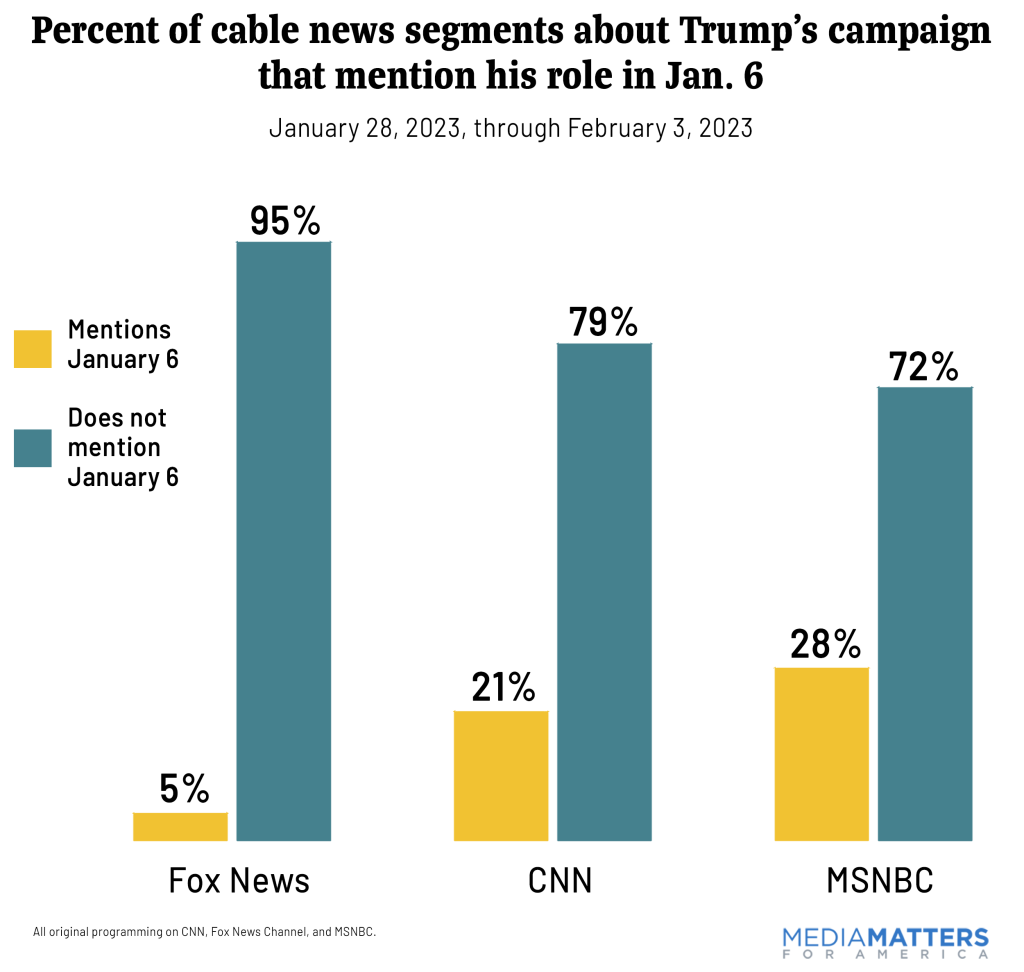
After President Joe Biden announced his reelection bid in April, we found that media coverage would often highlight his age but not Trump's, even though the former president is only three years younger.
Reviewing five months of coverage in major newspapers, we found that of all the articles that mentioned the age of either candidate, all five papers mentioned Biden’s age a great deal more.

We further determined that cable news mentioned Biden’s age 4 times as often as Trump’s in a four-day period in September beginning with the release of a poll that included questions about both candidates’ ages and health.
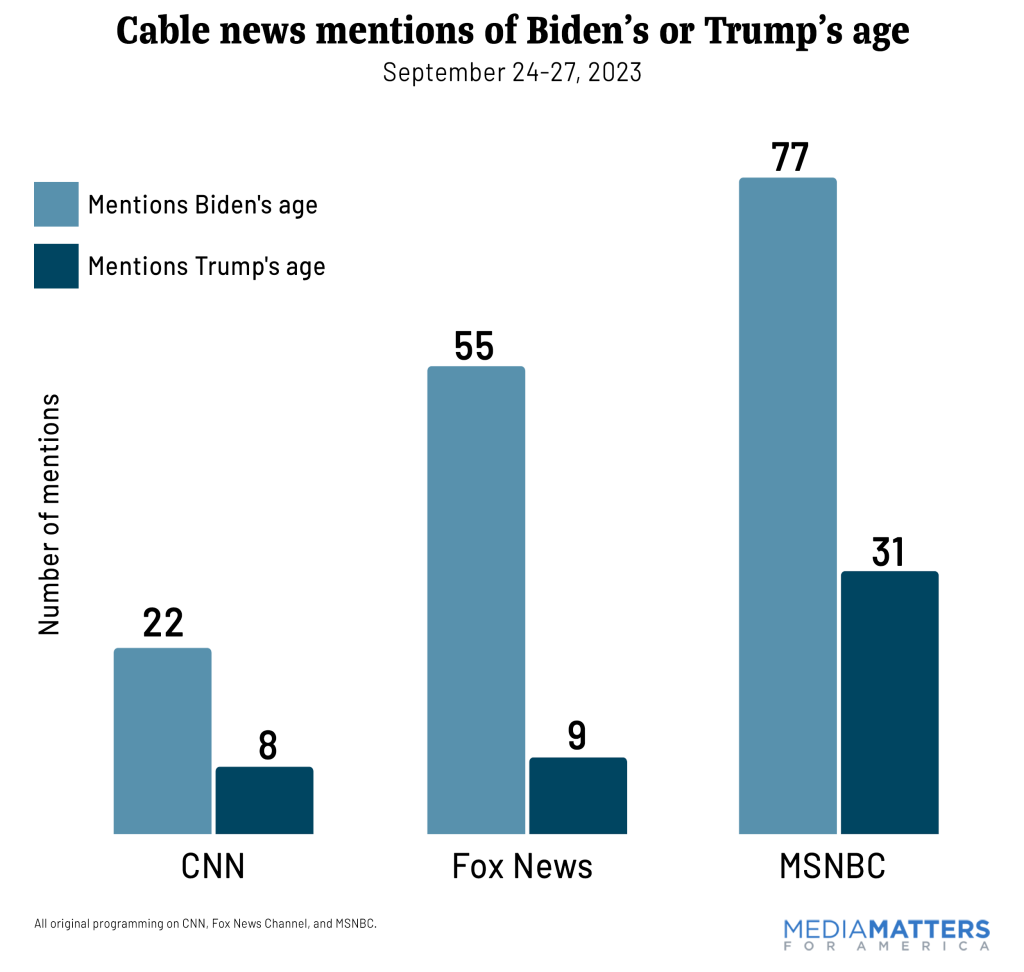
Major outlets not only provided comparatively little coverage of Trump’s age, but they also downplayed a series of verbal gaffes and incoherent statements he made. In September and October, Trump mixed up the authoritarian leaders of Hungary and Turkey; confused his former Republican opponent Jeb Bush and Jeb’s brother, former President George W. Bush; mixed up a number of his Democratic opponents with former President Barack Obama; and made a garbled statement accusing Biden of leading the country into “World War II.”
None of those remarks were covered on broadcast news, and they received relatively light coverage from the cable networks.
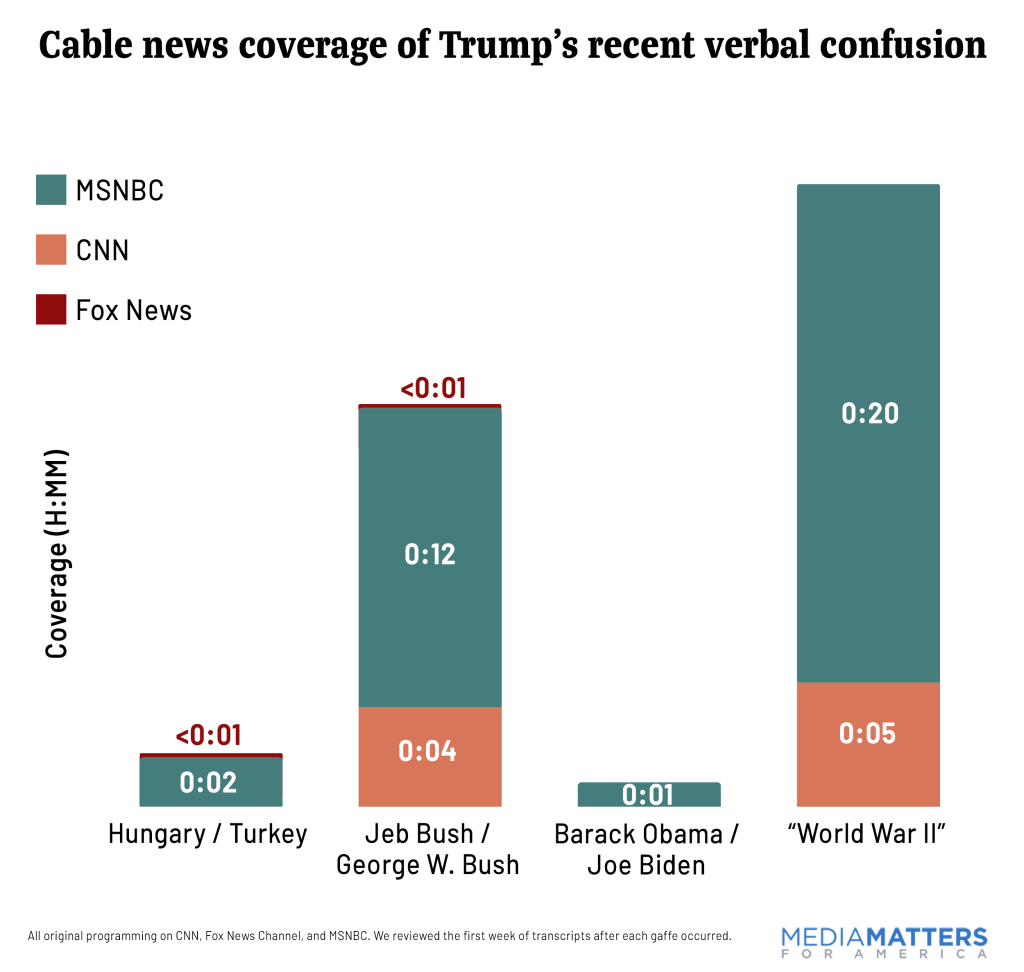
We also found that Trump received relatively lax coverage for a series of unhinged, extremist comments he made over the last four months of the year.
When the former president and likely Republican nominee suggested that Gen. Mark Milley, then chairman of the Joint Chiefs of Staff, deserved to be executed for his criticism of Trump, the comments were ignored by the Big Three broadcast networks and Fox, and they received 21 and 41 minutes of coverage, respectively, from CNN and MSNBC.
We subsequently reviewed coverage after Trump complimented the terrorist group Hezbollah as “very smart”; accused migrants of “poisoning the blood of our country”; said that “liberal Jews” are voting “to destroy America”; and called for “ideological screening” of immigrants and the barring of those who don’t like “our religion.”
Only the Hezbollah remark received more than 12 minutes of coverage from a cable news network or any broadcast coverage at all (just over 1 minute of coverage combined across ABC and NBC).
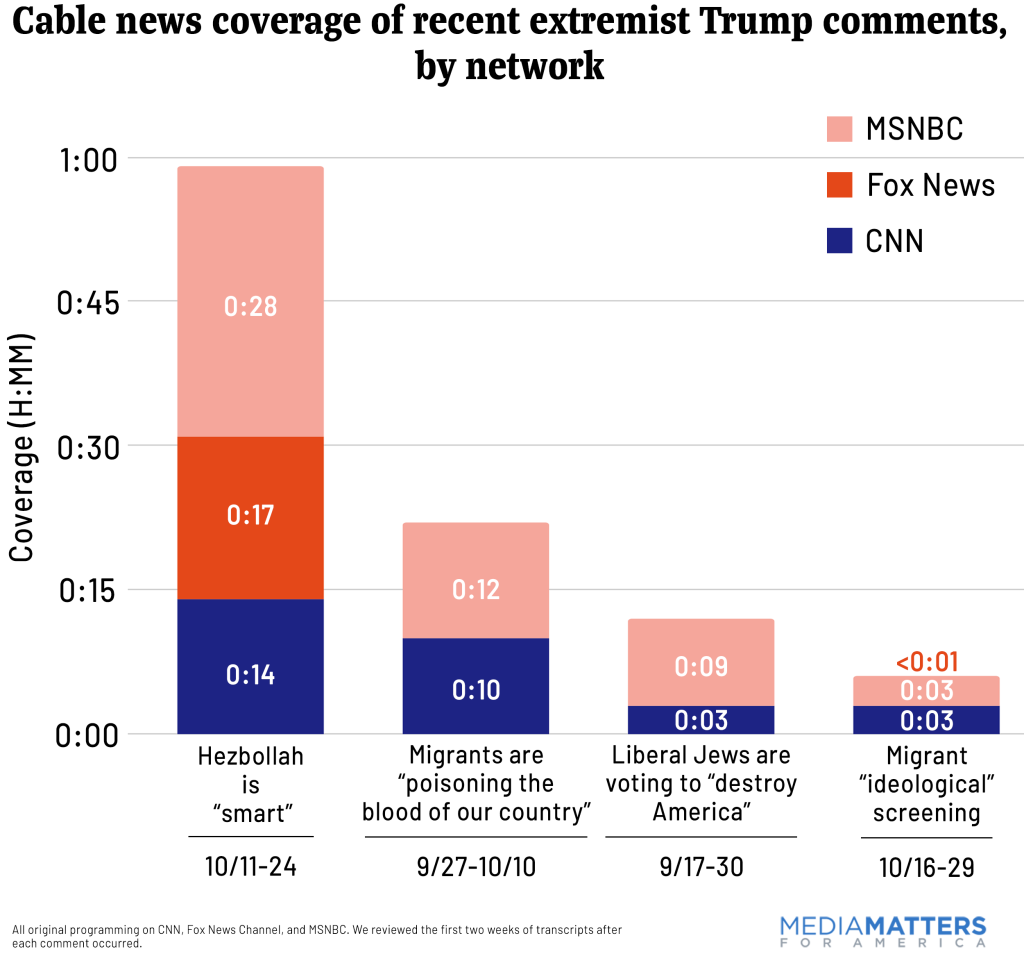
Likewise, in November Trump repeatedly pledged to “root out” his political opponents, who he claimed “live like vermin within the confines of our country” and want to “destroy America,” drawing comparisons from experts on authoritarianism to the rhetoric of genocidal fascist dictators.
But the remarks were largely ignored, drawing significantly less coverage from major outlets than the outlets gave Clinton’s description of some Trump supporters as a “basket of deplorables” in 2016.

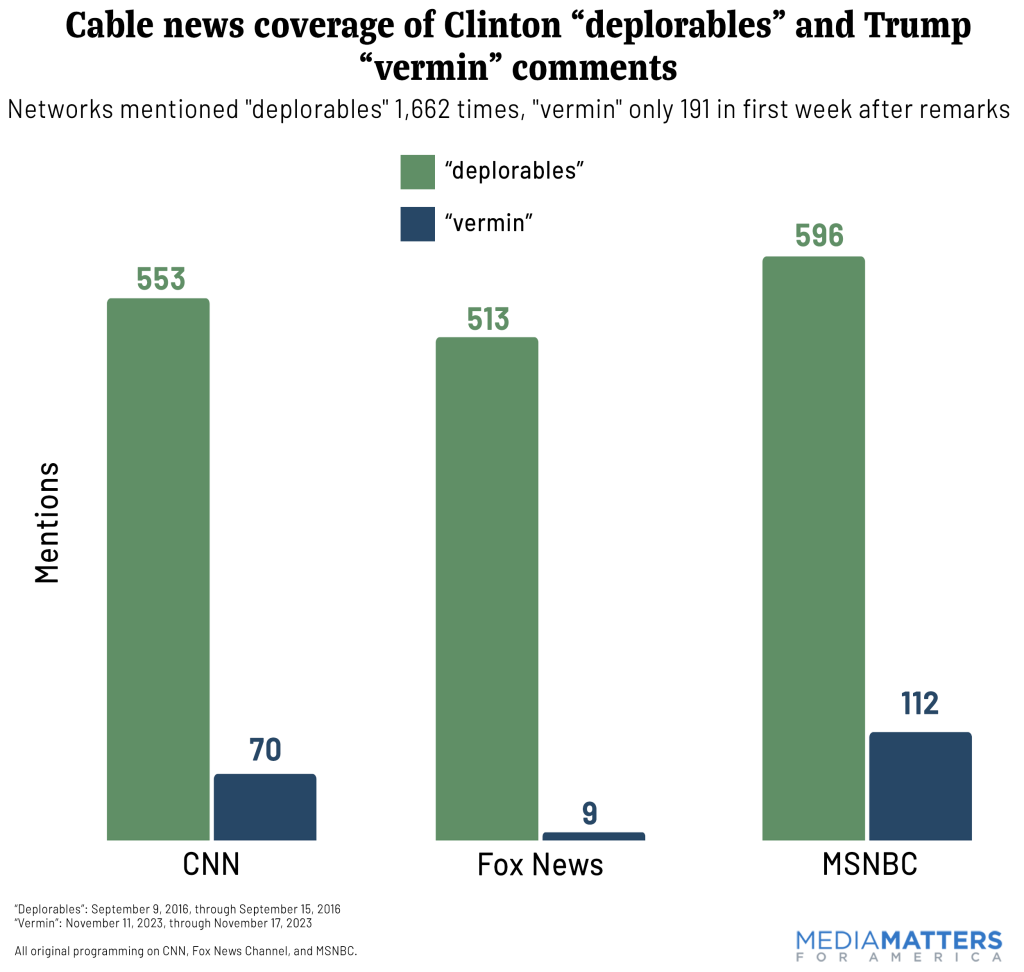

The legacy press did no better in covering some of Trump’s most consequential policy ideas this year.
Trump announced in August that he plans to impose a 10% tariff on all imported goods, the revenue from which his campaign team said would go toward tax cuts slanted toward the rich. Experts decried the tariff plan as “a disaster for the U.S. economy” that would raise prices for American consumers, particularly the poor and middle class, and potentially trigger “global economic chaos.”
But Trump’s tariff proposal received vanishingly little television coverage over the following month. ABC, CBS, and NBC did not cover it on their national morning, evening, or Sunday political talk shows. CNN and MSNBC each provided less than 1 minute of coverage, within a single segment, and neither addressed the potential impact for Americans, while Fox ignored the plan.
In November, Trump said that if he is elected he wants to “terminate” the Affordable Care Act, which provides health coverage to 35 million Americans and protects the coverage of many more with preexisting conditions. We found that the broadcast networks totally ignored Trump’s threat. While the cable news networks covered Trump’s threat in 35 segments, they largely ignored its potential consequences for the public.
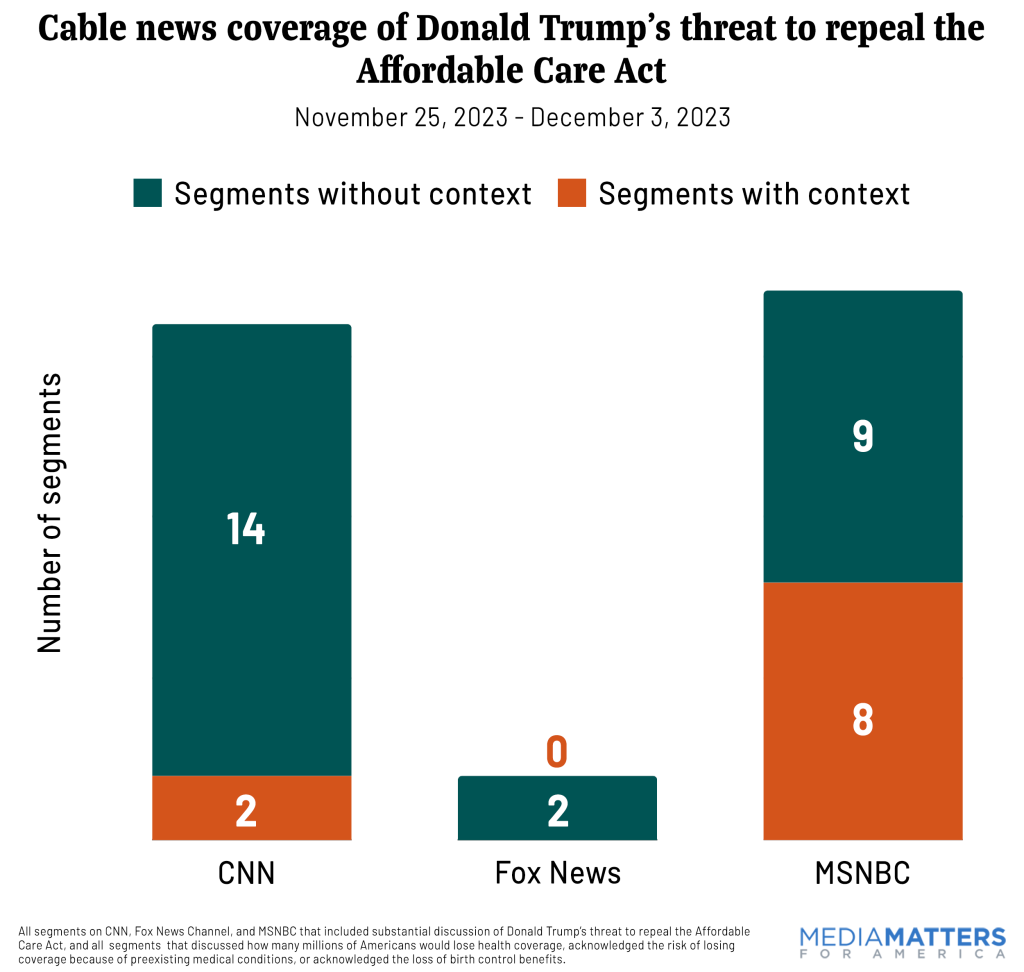
2024 will push political journalism to the breaking point
There were signs of improvement as the year came to a close. The New York Times produced major investigations on the Trump team's radical, authoritarian plans for if he returns to power, while The Atlantic devoted an entire issue to analyzing what will occur “If Trump Wins.” Each set the agenda for the rest of the press, drawing substantial secondary coverage.
The legacy press also might be turning a corner on coverage of Trump’s extremist rhetoric. When he first accused migrants of “poisoning the blood of our country” in a September speech, ABC, CBS, and NBC all ignored the comment, while CNN, Fox, and MSNBC combined to give it only 22 minutes of coverage over two weeks. But when he repeated the vile remark in December, the same outlets gave it the attention it deserved: Each broadcast network ran at least 3 segments on the comment, and the cables combined for more than 11 times as much airtime (245 minutes) over the course of only four days.
It's possible that as the presidential primaries come to a close, reporting focusing on “not the odds, but the stakes” will become more of the norm rather than the exception.
But the job of the political press will become only more difficult over the next year. Republicans and right-wing media will pressure journalists to repeat the mistakes they made during Trump’s first general election campaign. They have spent years assembling a series of debunked conspiracy theories and bad-faith innuendoes related to the business interests of Biden’s son, Hunter, and next year they plan to leverage those phony grievances to impeach the president. Republicans recognize that they lack actual incriminating evidence of wrongdoing by Joe Biden — but they know that if they can stir up a scandal, they can give legacy news outlets something to talk about besides Trump’s alleged criminality.
Fox News host Jesse Watters laid out the plan in August.
“Without the impeachment, you have back-to-back-to-back-to-back Trump trials,” he explained. “The media’s not going to cover anything else. Biden’s going to hide, and Trump is going to be criminalized on TV. But if Republicans time this right and follow the evidence where it leads, impeachment is going to run counter to the Trump trials next year.”
Watters knows that such a plan could work on journalists because a similar approach succeeded in 2016. A return to that form would put the American experiment in democracy — and the free press itself — in jeopardy.
